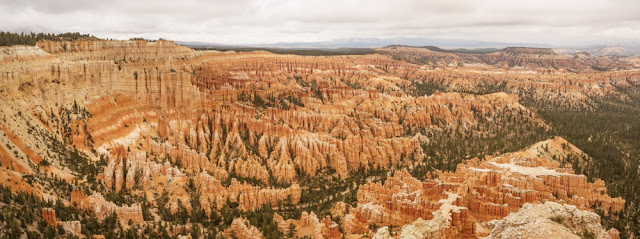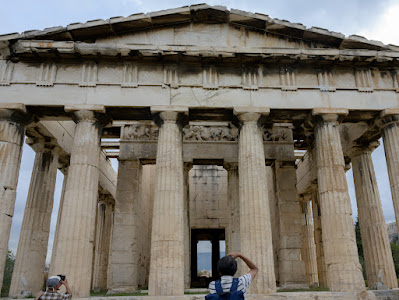Glorious Utah, spectacular Bryce Point
Not being quite methodical we left out the next stop on our trip up Bryce Canyon and went straight to Bryce Point, an enormous amphitheatre of pinnacles. Here is a panorama to show the size of the place. The individual hoodoos can reach up to 200ft to give you an idea of scale. Needless say we were mightily impressed.
After lunch we went on a guided geology tour where we learnt more about the rock formation at Bryce. The Canyon stands at the edge of the Paunsaugant Plateau on the northern edge of the Grand Staircase, a huge collection of steps in the landscape of the Colorado Plateau leading down to the Grand Canyon.
The rock at Bryce is known as the Claron Formation, a collection of limestone, silts and mudstone, sometimes topped with a layer of dolomitic limestone which is much harder than normal limestone and resilient to acid rain. The plateau edge is being continually eroded, mainly by frost damage but also by water flow off the edge of the canyon and is receding at a rate of 2-4ft every hundred years. The pinnacles or hoodoos form as the different mineral layers in the rock are eroded at different rates, the limestone eroding fastest. The hoodoos topped with the harder dolomitic limestone last longer but others will erode and fall, while new ones are being created at the plateau edge.
But please just enjoy the scenery at Bryce Point before the next blog, and a couple of phone pictures of Mike at the viewpoint.
The rock at Bryce is known as the Claron Formation, a collection of limestone, silts and mudstone, sometimes topped with a layer of dolomitic limestone which is much harder than normal limestone and resilient to acid rain. The plateau edge is being continually eroded, mainly by frost damage but also by water flow off the edge of the canyon and is receding at a rate of 2-4ft every hundred years. The pinnacles or hoodoos form as the different mineral layers in the rock are eroded at different rates, the limestone eroding fastest. The hoodoos topped with the harder dolomitic limestone last longer but others will erode and fall, while new ones are being created at the plateau edge.
But please just enjoy the scenery at Bryce Point before the next blog, and a couple of phone pictures of Mike at the viewpoint.



















Comments
Post a Comment